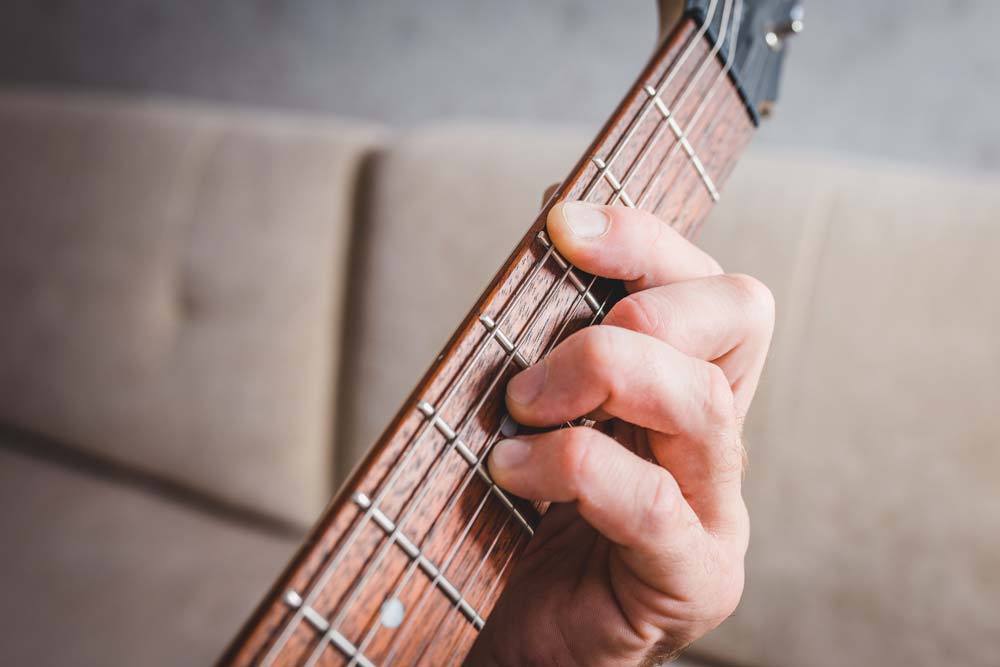Full of emotion, the C minor chord (also known as Cm guitar chord) transcends musical genres. Its soft and emotive nature is the perfect match to translate words of lost love or distress.
Considering the chord oozes despondency/sadness and tends to pull at the heartstrings, It’s easy to understand its popularity with songwriters.
And yet, budding guitarists often overlook the C minor guitar chord.
One of the main reasons this chord is overlooked is because Cm is a barre chord, and learning barres can be especially tricky for a beginner.
In today’s article, we’ll show you a way around this (if you’re not quite at that level yet).
It’s also worth noting that a natural place to start as a beginner is with the chords G and D major. The B minor is comparatively a logical chord to play alongside these.
Either way, let’s dive in and learn how to play the neglected and unsung hero of guitar chords—the beautiful C minor.
Contents
- 1 Playing The C Minor Guitar Chord
- 2 Playing C Minor Guitar Chord (without barre – easy 4 finger version)
- 3 Playing C Minor Guitar Chord (no barre – easiest 3 finger version)
- 4 Playing C Minor 7 Guitar Chord
- 5 Playing C Minor 9 Guitar Chord
- 6 What Notes Make The C Minor Chord
- 7 What Songs Use The C Minor Chord?
- 8 Conclusion
Playing The C Minor Guitar Chord
In its most standard form, we typically play Cm as a barre chord. There are two ways of attacking it, either on the 3rd fret or the 8th.
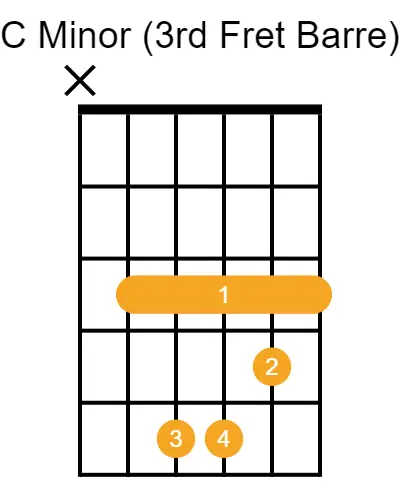
To play a standard Cm:
- Use your index finger to bar the 3rd fret.
- Now place your middle finger on the 4th fret on the B string.
- Last, place your ring finger on the 5th fret D string and your pinky on the 5th fret G string.
This is a common chord shape when playing minor guitar chords in standard tuning. Once you’ve mastered this chord, you can move it to the 2nd fret to play B minor or the 5th fret to play D minor.
An alternative way to play the C minor guitar chord is by using another common minor chord shape. You may find this technique easier as it uses fewer fingers.

An alternative method to play a standard Cm:
- First barre the 8th fret using your index finger. Your middle finger will be free with this technique, so you can use it to rest on top of the index finger and add pressure.
- Now place your ring finger on the 10th fret A string and the pinky finger on the 10th fret D string.
Like the shape you used on the 3rd fret, this finger position can translate along the neck to create other minor chords. Because of its commonality, this is worth mastering to have in your arsenal.
You can also use this shape on the 5th fret for an A minor or the 1st fret for F minor.
Playing C Minor Guitar Chord (without barre – easy 4 finger version)
Barre chords can be somewhat daunting if you’re a beginner. Your fingers might not be flexible enough to combat the full barre chords yet.
But, no need to worry. Here’s a technique to play an abbreviated C minor without needing to barre the strings. It is similar to how you play an F major 7th, albeit on the lower strings.

To play a Cm chord (without barre):
- Place your index finger at the 3rd fret of the high e string.
- Now place your middle finger on the 4th fret b string.
- Then place your ring and pinky finger on the 5th fret (on the respective D and G strings).
Playing C Minor Guitar Chord (no barre – easiest 3 finger version)
Want an easier method of playing the C minor chord? This shape is further abbreviated for simplicity. Once you’re comfortable with this technique, try adding more fingers. With practice, you’ll be playing the full barre chord in no time.

To play a Cm Guitar chord (no barre – 3 finger version):
- Place your index finger on the 3rd fret high e string.
- Place your middle finger on the 4th fret b string.
- Place your ring finger on the 5th fret G string.
Playing C Minor 7 Guitar Chord
The C minor 7 chord is a variation of the minor chord. You’ll often find it abbreviated as Cm7.
In music theory, minor 7th chords comprise four notes.
The two fundamental techniques for playing Cm7 follow a similar shape to the standard Cm barre shapes. On both the 3rd and 8th fret techniques, simply release the pinky finger away from the fretboard.
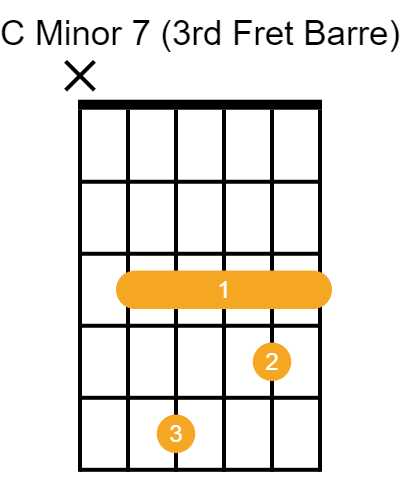
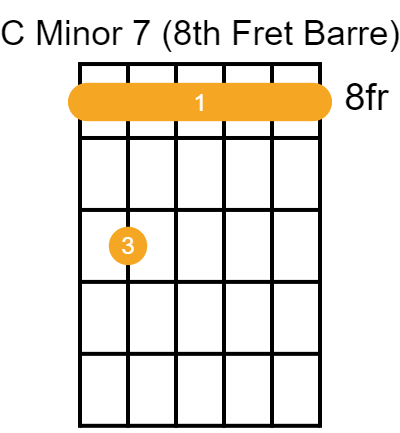
Playing C Minor 9 Guitar Chord
The standard method to play a C minor 9 chord differs in shape from the previous chord formations. In this method, the A string plays the root note.
Songwriters seldom use this chord in pop music, but it’s very prevalent in jazz. This can be a hard nut to crack for beginners, but if you’re up for a challenge, why not give it a go?
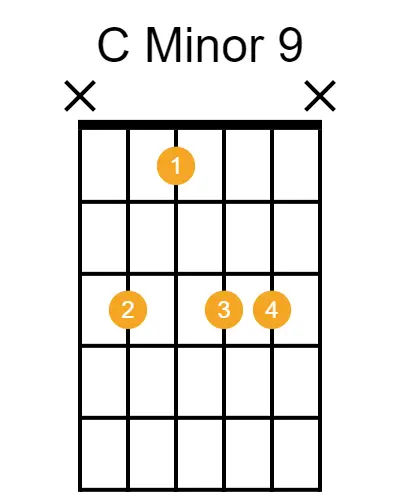
There are different ways to attack this. A good way to train your fingers is to start with your ring and pinky finger on the 3rd fret on the respective G and B strings. You can then try to place your index finger on the first fret and middle finger on the third.
What Notes Make The C Minor Chord
Are you curious about what notes make up the Cm chord for music theory? This can also be useful if you’re hoping to delve into production and MIDI instruments.
C Minor contains three notes:
- C
- Eb (E flat)
- G
What Songs Use The C Minor Chord?
Adele’s ‘Rolling in the Deep‘ uses a palm-muted C5 to create an impressive effect. The C5 is the C minor yet requires plucking fewer strings. When the chorus arrives, this song broadcasts the C minor to its full extent.
Similarly, if you’re in search of another motivational tune, look no further than ‘Eye of the Tiger‘ by Survivor. This classic showcases another dimension to the CM chord.
Conclusion
So there we have it, a guide to playing the C Minor chord.
Sure, It can be a bit disheartening if you don’t get it straight away, but keep going!
Barre chords take time and practice to conquer. You may hear muting on some strings as a beginner, but don’t worry. As your technique improves, you’ll hear a noticeable improvement.
Feel like giving this post a share to help your fellow guitarist? Let us know how you get on; we love to hear your feedback and any musical ideas you have.


